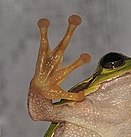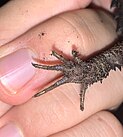Finger
| Finger | |
|---|---|
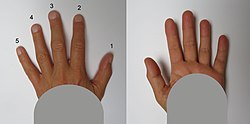 The fingers of a left hand seen from both sides | |
| Details | |
| Identifiers | |
| Latin | digiti manus |
| MeSH | D005385 |
| TA98 | A01.1.00.030 |
| TA2 | 150 |
| FMA | 9666 |
| Anatomical terminology | |
A finger is a prominent
Land vertebrate fingers
As terrestrial vertebrates were
Research has been carried out on the
Human fingers
Usually humans have five digits,
English dictionaries describe finger as meaning either one of the five digits including the thumb, or one of the four digits excluding the thumb (in which case they are numbered from 1 to 4 starting with the index finger closest to the thumb).[1][2][12]
Structure
Skeleton
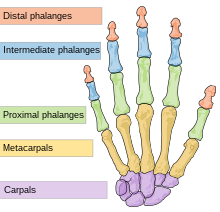
The thumb (connected to the trapezium) is located on one of the sides, parallel to the arm.
The palm has five bones known as metacarpal bones, one to each of the five digits. Human hands contain fourteen digital bones, also called phalanges, or
- metacarpophalangeal joint (MCP) – the joint at the base of the finger
- proximal interphalangeal joint (PIP) – the joint in the middle of the finger
- distal interphalangeal joint (DIP) – the joint closest to the fingertip.
The
Muscles
Each finger may
Fingers do not contain muscles (other than
. The long tendons that deliver motion from the forearm muscles may be observed to move under the skin at the wrist and on the back of the hand.Muscles of the fingers can be subdivided into extrinsic and intrinsic muscles. The extrinsic muscles are the long flexors and extensors. They are called extrinsic because the muscle belly is located on the forearm.
The fingers have two long flexors, located on the underside of the forearm. They insert by tendons to the phalanges of the fingers. The deep flexor attaches to the distal phalanx, and the superficial flexor attaches to the middle phalanx. The flexors allow for the actual bending of the fingers. The thumb has one long flexor and a short flexor in the thenar muscle group. The human thumb also has other muscles in the thenar group (
The extensors are located on the back of the forearm and are connected in a more complex way than the flexors to the dorsum of the fingers. The tendons unite with the interosseous and lumbrical muscles to form the extensorhood mechanism. The primary function of the extensors is to straighten out the digits. The thumb has two extensors in the forearm; the tendons of these form the
The intrinsic muscle groups are the
Skin
Aside from the genitals, the fingertips possess the highest concentration of touch receptors and thermoreceptors among all areas of the human skin,[17] making them extremely sensitive to temperature, pressure, vibration, texture and moisture. A study in 2013 suggested fingers can feel nano-scale wrinkles on a seemingly smooth surface, a level of sensitivity not previously recorded.[18] This makes the fingers commonly used sensory probes to ascertain properties of objects encountered in the world, making them prone to injury.
The pulp of a finger is the fleshy mass on the palmar aspect of the extremity of the finger.[19]
Fingertip wrinkling in water
Although a common phenomenon, the underlying functions and mechanism of fingertip wrinkling following immersion in water are relatively unexplored. Originally it was assumed that the wrinkles were simply the result of the skin swelling in water,[20] but it is now understood that the furrows are caused by the blood vessels constricting due to signalling by the sympathetic nervous system in response to water exposure.[21][22] One hypothesis for why this occurs, the "rain tread" hypothesis, posits that the wrinkles may help the fingers grip things when wet, possibly being an adaption from a time when humans dealt with rain and dew in forested primate habitats.[21] A 2013 study supporting this hypothesis found that the wrinkled fingertips provided better handling of wet objects but gave no advantage for handling dry objects.[23] However, a 2014 study attempting to reproduce these results was unable to demonstrate any improvement of handling wet objects with wrinkled fingertips.[22]
Regrowth of the fingertips
Fingertips, after having been torn off children, have been observed to regrow in less than 8 weeks.
Brain representation
Each finger has an orderly somatotopic representation on the
The somatosensory cortex representation of the hand is a dynamic reflection of the fingers on the external hand: in
Clinical significance
Anomalies, injuries and diseases
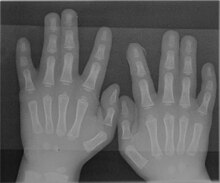
A rare anatomical variation affects 1 in 500 humans, in which the individual has more than the usual number of digits; this is known as polydactyly. A human may also be born without one or more fingers or underdevelopment of some fingers such as symbrachydactyly. Extra fingers can be functional. One individual with seven fingers not only used them but claimed that they "gave him some advantages in playing the piano".[30]
The fingers are commonly affected by diseases such as
Research has linked the ratio of lengths between the index and ring fingers to higher levels of testosterone, and to various physical and behavioral traits such as penis length[31] and risk for development of alcohol dependence[32] or video game addiction.[33]
Etymology
The English word finger stems from Old English finger, ultimately from Proto-Germanic *fingraz ('finger'). It is cognate with Gothic figgrs, Old Norse fingr, or Old High German fingar. Linguists generally assume that *fingraz is a ro-stem deriving from a previous form *fimfe, ultimately from Proto-Indo-European *pénkʷe ('five').[34]
The name pinkie derives from Dutch pinkje, of uncertain origin. In English only the digits on the hand are known as fingers. However, in some languages the translated version of fingers can mean either the digits on the hand or feet. In English a digit on a foot has the distinct name of toe.
See also
Notes
- ^ a b Chambers 1998 p. 603
- ^ a b c Oxford Illustrated pp. 311, 380
- Walter Gehring: Zoologie. Thieme Verlag Stuttgart/ New York, 1990, pp. 550 and 723-726.
- Jane B. Reece: Biology. Heidelberg/ Berlin 2003, pp. 515-517 and 583.
- PMID 15175371. Retrieved 6 September 2021.
- PMID 21676713. Retrieved 6 September 2021.
- PMID 33257543.
- ^ V. Garcia-Martinez, D. Macias et al: Internucleosomal DNA fragmentation and programmed cell death (apoptosis) in the interdigital tissue of the embryonic chick leg bud. In: Journal of Cell Science. Vol. 6, Issue 1, September 1993, pp. 201-208.
- ^ M. A. Fernandez-Teran, J. M. Hurle: Syndactyly induced by Janus Green B in the embryonic chick leg bud: a reexamination. In Development, Volume 8, Issue 1, December 1984, pp. 159–175.
- ^ Sajid Malik: Syndactyly: phenotypes, genetics and current classification. In: European Journal of Human Genetics. Vol. 20, 2012, pp. 817–824.
- ISBN 978-1-4939-3646-5.
- ^ Oxford Advanced p. 326
- PMID 23300946.
- S2CID 46568801.
- S2CID 23697755.
- S2CID 237545122.
- ISBN 978-0-262-54205-0.
- Science Daily. September 16, 2013.
- ^ medilexicon.com > Medical Dictionary - 'Pulp Of Finger' Citing: Stedman's Medical Dictionary. 2006
- ISBN 978-0-323-81123-1.
- ^ PMID 21701145.
- ^ PMID 24416318.
- PMID 23302867.
- ^ Siegel, Jake. "Kids can regrow a fingertip. Why can't adults?". University of Washington Newsroom. University of Washington. Archived from the original on 1 November 2021. Retrieved 1 November 2021.
- ^ Doucleff, Michaeleen (12 June 2013). "Chopped: How Amputated Fingertips Sometimes Grow Back". National Public Radio. Retrieved 1 November 2021.
- PMID 15320953.
- PMID 18245039.
- S2CID 21042040.
- PMID 8386377.
- ^ Dwight, T (1892). "Fusion of hands". Memoirs of the Boston Society of Natural History. 4: 473–86.
- ^ "Penis Size Linked to Length of Fingers". men.webmd.com. Retrieved 24 July 2022.
- PMID 21547078.
- PMID 24236143.
- ISBN 978-90-04-18340-7.
References
- ISBN 0-550-14000-X.
- The Oxford Illustrated Dictionary. Great Britain: Oxford University Press. 1976 [1975].
- Oxford Advanced Learner's Dictionary of Current English. London: Oxford University Press. 1974 [1974]. ISBN 0-19-431102-3.

